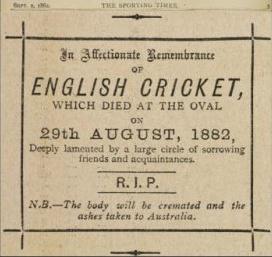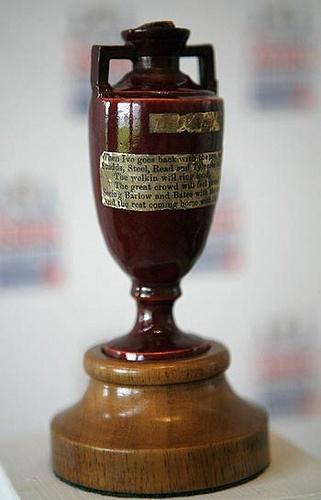The Ashes Urn Is Not a Trophy
| sport
Whenever Australia wins or retains the Ashes, people call for “the urn” to be sent home with the team, believing it to be a trophy. It’s an understandable assumption, but the urn’s history shows that they are incorrect.

Most cricket fans know the story - after Australia beat England in an 1882 test match, a mock obituary appeared in The Sporting Times “in Affectionate Remembrance of English Cricket”. The final line of the obituary reads, “The body will be cremated and the Ashes taken to Australia”. Thus began one of the most enduring sports legends.
The obituary was a great joke, and English captain Ivo Bligh (later to become Lord Darnley) declared that he’d regain “the Ashes” when England toured Australia in 1882-83. He referred to “the Ashes” several times during the tour, and the Australian media ran with it. The term then fell out of use for twenty years before being cemented by English captain Plum Warner when he published How We Recovered The Ashes in 1903.
The Ashes legend was forty-five years old when the general public became aware of a certain urn. The following poem, appearing in The Cricketers Annual in 1925, indicates as much:
So here’s to Chapman, Hendren and Hobbs, Gilligan, Woolley and Hearne: May they bring back to the Motherland, The ashes which have no urn!
(For the record, England was thumped 4-1.)
In 1927 Florence Bligh, widow of Ivo Bligh, gave the Marylebone Cricket Club a small terracotta urn that had been given to her husband some years prior. Although the details are disputed it is believed that a group of Victorian women, picking up on the “ashes” term used by the media, awarded him the urn after England’s series victory in 1883.
The urn was a personal gift to Bligh, and was later a personal gift to the MCC. It is known as the “Darnley urn” to distinguish it from other, less celebrated urns that have surfaced over the years.
The Darnley urn was kept in the Long Room at Lord’s until 1953, when it was moved to the MCC Museum at the same ground. Its prominence has led many to assume that the test series is named for it alone, and they believe it to be the trophy. The Ashes, however, are metaphorical. It is an idea created by The Sporting Times, and one which grew in stature as it collected more stories. The Darnley urn is just one of those stories.

No doubt there are those who would read this and say, “so what?” Despite the history, they would claim that the Darnley urn has come to represent the Ashes for most people and should therefore be considered a trophy. I do not agree.
The urn is delicate and belongs in a museum so that it can be correctly maintained. The MCC respected the wishes of the Australian public and created a large replica trophy of Waterford Crystal to award to victorious teams. If we must have a trophy, this is more suitable than a 125-year-old terracotta artefact.
I don’t understand the attraction to trophies. I believe that the idea is more compelling than a trophy could ever be. The death of English cricket! What a notion! Since 1882 we’ve been playing tests to either regain England’s honour, or to rub her nose in it some more (depending on whose side you’re on). How simply marvellous. I doubt I’ll convince many of my fellow Australians to come around to my way of thinking; we’re too fixated on the physical, on ownership, on possession. If people know the history, though, we can debate these last points alone.
Neda